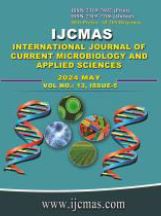


 National Academy of Agricultural Sciences (NAAS)
National Academy of Agricultural Sciences (NAAS)

|
PRINT ISSN : 2319-7692
Online ISSN : 2319-7706 Issues : 12 per year Publisher : Excellent Publishers Email : editorijcmas@gmail.com / submit@ijcmas.com Editor-in-chief: Dr.M.Prakash Index Copernicus ICV 2018: 95.39 NAAS RATING 2020: 5.38 |
Surgical site infection (SSI) is defined as a proliferation of pathogenic microorganisms which develops in an incision site either within the skin and subcutaneous fat (superficial) and musculofascial layers (deep) or in an organ or cavity, if opened during surgery. SSIs account for 20% to 25% of all hospital acquired infections worldwide. The rate of HAIsis markedly higher in many developing countries. The present study aimed at obtaining the incidence of SSI and to evaluate the risk factors as well as to formulate an antibiotic policy for patients posted for any surgery in Tirunelveli medical college hospital. To determine the rate of surgical site infection among patients admitted in Intensive surgical care unit and post surgical ward in a tertiary care hospital.2. To isolate the pathogens and find the antibiotic susceptibility pattern. The Study Population and Size is 50. The Study Period is March 2017 to August 2017. Department of Microbiology. The Study Sample was collected from patients who developed SSI. Two wound swabs were collected aseptically a. Gram stain microscopy using first swab.b. Inoculation on culture media using second swab c. Identification of the isolates by standard biochemical test. d. Antimicrobial susceptibility testing by Kirby Bauer disk diffusion method. Ethical clearance from institutional ethics committee Tirunelveli medical college. Surveillance for SSIs in each centre will determine the rate of SSIs, distribution of micro organism and antimicrobial susceptibility pattern of the isolates. Empirical treatment of the SSIs can be made using these relevant data which will ensure reduced patient stay, morbidity, cost per day in the hospital.
Agarwal S L. Rao A S, Harsha M. Study of postoperative wound infection. Indian J Surg 1972; 34: 314 20. J Indian Med Assoc 1975; 64:90-3.
Amare, B., Z. Abdurrahman, B. Moges, and J. Ali, “Postoperative surgical site bacterial infections and drug susceptibility patterns at Gondar University Teaching Hospital, Northwest Ethiopia,” Journal of Bacteriology & Parasitology, vol. 2, no. 8, 2011. https://doi.org/10.4172/2155-9597.1000126
Bagnall, N. M., S. Vig, and P. Trivedi, (2009) “Surgical-site infection,” Surgery, vol. 27, no. 10, pp. 426–430. https://doi.org/10.1016/j.mpsur.2009.08.007
Berard F and Gandon J. Factors influencing the incidence of wound infection. Ann Surg 1964; 160:32-81
Cruse P J E. Surgical wound infection. In: Gorbach S L, Bartlett J G, Blacklow N R editors. Infectious disease. W. B. Saunders Company, Harcourt Brace Jovanovich, Inc.: Philedelphia. London, Toranto, Montreal, Sydney. Tokyo; 1992:738-64.
Gelaw, A., S. Gebre Selassie, M. Tiruneh, and M. Fentie, “Antimicrobial susceptibility patterns of bacterial isolates from patients with postoperative surgical site infection, health professionals and environmental samples at a tertiary level hospital, North West Ethiopia,” International Journal of Pharmaceutical Sciences Review and Research, vol. 3, no. 1, pp. 1–9, 2013.
Lilani S P, Jangale N, Chowdhary A, Daver G B. Surgical site infection in clean and clean-contaminated cases. Indian J Med Microbiol 2005;23:249-52. https://doi.org/10.1016/S0255-0857(21)02530-5
Mahesh C B, Shivakumar S, Suresh B S, Chidanand S P, Vishwanath Y. A prospective study of surgical site infections in a teaching hospital. J ClinDiagn Res2010;4:3114-9.
Malik S, Gupta A, Singh K P, Agarwal J, Singh M. Antibiogram of Aerobic Bacterial Isolates from Post-operative Wound Infections at a Tertiary Care Hospital in India. J Infect Dis Antimicrob Agents 2011;28:45-52
Mangram A J, Horan T C, Pearson M L, Silver L C, Jarvis W R, The Hospital Infection Control Practices Advisory Committee. Guideline for prevention of surgical site infection, 1999. Infect Control Hosp Epidemiol 1999;20:247-78.
Prabhakar H, Arora S. A bacteriological study of wound infections. J Indian Med Assoc 1979; 73(9and10):145-8.
Reichman, D. E. and J. A. Greenberg, “Reducing surgical site infections: a review,” Reviews in Obstetrics & Gynecology, vol. 2, no. 4, pp. 212–221, 2009.
Sapana Mundhada, Anu Sharma, Kishor Ingole, Sadiya Shaikh. 2017. Prevalence of Pseudomonas aeruginosa in Surgical Site Infection in a Tertiary Care Centre. Int.J.Curr.Microbiol.App.Sci. 6(4): 1202-1206 https://doi.org/10.20546/ijcmas.2017.604.147
Thu, L. T. A., A. H. Sohn, N. P. Tien et al., “Microbiology of surgical site infections and associated antimicrobial use among Vietnamese orthopedic and neurosurgical patients,” Infection Control and Hospital Epidemiology, vol. 27, no. 8, pp. 855–862,2006.
Tripathy B S, Roy N. Post-operative wound sepsis. Ind J Surg 1984; 47:285-8.
 |
 |
 |
 |
 |